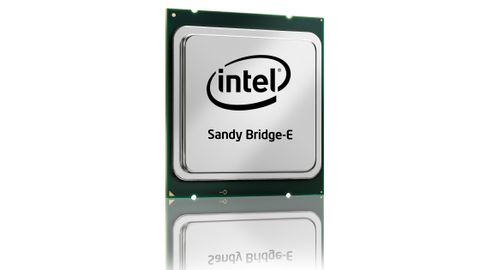Why you can trust TechRadar

First, let's address the elephant in the room.
There's no mention of it in Intel's official documentation, but the image Intel has provided of the new Intel Core i7-3960X's die makes one thing perfectly clear: this is an eight-core PC processor with two cores disabled.
For now, we can only speculate on Intel's strategy, even if we do have a pretty solid hunch. But more on that in a moment.
Architecturally, the Intel Core i7-3960X is part of the the Sandy Bridge family. That makes it a 32nm processor with thoroughly revised internals compared with the previous six-core Gulftown processor. That, too, is a 32nm chip, but its Westmere-vintage architecture is merely a die shrink of the earlier Nehalem family.
Not that Nehalem, Westmere and Gulftown are stinkers. Quite the contrary.
The point is that the Core i7-3960X and its sister Sandy Bridge E chips bring Intel's high-end processor offering up to date.
Predictably, therefore, many of the best bits of Sandy Bridge already seen in processors for the LGA 1,155 socket make an appearence.
That means everything from Intel's latest iteration of Smart Cache, Hyper-Threading and Turbo Boost are all in the mix. Likewise, you get support for the latest SSE4.2 instructions, along with AVX and AES extensions.
There are also a number Sandy Bridge E-specific extras that don't apply to previous Sandy Bridge chips and are largely related to the chipset and peripherals.

Most obvious is the new LGA 2,011 socket, which has a big increase in pins over the Intel's existing LGA 1,366 high-end desktop socket. The explanation is an upgrade from a triple to a quad-channel memory interface.
Now, Intel's LGA1,366 platform was hardly memory starved in the desktop environment. What's more, since Intel is sticking with six cores on the new i7, increased demand for bandwidth is likely to be marginal.
But here's the thing. Just like the LGA 1,366 platform, LGA 2,011 is really a server and workstation solution that Intel has given a quick buff, changed a few names on and chucked onto the desktop.
Four channels of memory is handy when you're talking about multi-socket systems with as many as 10 cores per socket. For a single-socket desktop platfrom that maxes out at six cores, it's overkill.
Anywho, other changes in the shift from LGA 1,366 on the old X58 chipset to LGA 2,011 on X79 include a single-chip chipset, PCI Express moving onto the processor die and an extra four PCI Express lanes for a grand total of 40.
Plenty, in other words, for multi-GPU action in just about any flavour you fancy.
The SATA ports also get an upgrade to 6Gbps. But there's no native USB 3.0, which is a bit of a bummer.
However, the really critical areas where the Core i7-3960X deviates from previous Sandy Bridge processors are twofold and not entirely unrelated. Again, we're talking about the uncore stuff.
Most notably, Sandy Bridge E is a pure CPU, there's no integrated graphics and that means no Quick Sync video encode acceleration. That's not an absolutely critical omission, but it is a little hard to swallow in the context of the 3960X's premium pricing.
Quick Sync is a nice feature and something you get even on the lowliest of LGA1,155 Sandy Bridge chips.
Sandy Bridge E's final change up involves overclocking.
Intel has introduced a new divider between the baseclock and the cores, known as the CPU strap. The net result of it is that baseclocks of 100MHz, 125MHz, 166MHz and 250MHz are available. Now, for an unlocked chip such as the 3960X, that's not a terribly big deal. You have full access to the standard CPU ratios on a per-core basis.
But for the more affordable partially locked members of the Sandy Bridge range, specifically the upcoming quad-core Core i7-3830, it makes all the difference and ensures the LGA2,011 platform offers something extra for enthusiasts.
Technology and cars. Increasingly the twain shall meet. Which is handy, because Jeremy (Twitter) is addicted to both. Long-time tech journalist, former editor of iCar magazine and incumbent car guru for T3 magazine, Jeremy reckons in-car technology is about to go thermonuclear. No, not exploding cars. That would be silly. And dangerous. But rather an explosive period of unprecedented innovation. Enjoy the ride.

